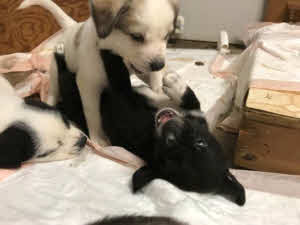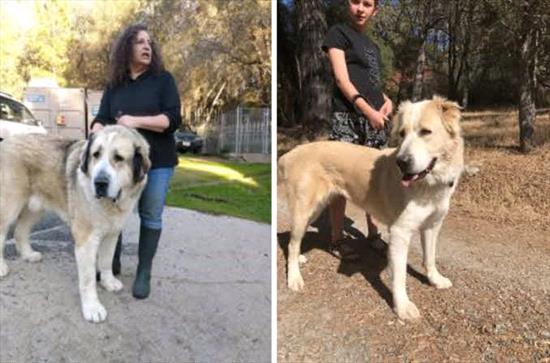I have to apologize as we fell a bit behind blogging about the pups. Here was what I was supposed to post 2+ weeks ago! I will have an update next week with pictures of them moving down to the “Livestock kennel”.
5/25/2018
Well, the puppies are now just over 5 weeks old and growing like weeds! Livestock Guardian Dog (LGD) Breeds are considered “giant” breeds and the pups grow very fast. At birth the entire litter averaged 1.3 lbs each (total litter weight of just under 12 lbs) and now, at 5 ½ weeks old, they are averaging over 9 lbs each, with the 2 biggest at over 11 lbs!. They are now gaining about 2 ½–3 lbs a week. This rate will slow a bit, but will continue until they are around 9–10 months old then slow way down. They will weigh between 90–105 lbs at a year and could top out (for the males) at over 130 lbs. The pups are being weaned and Mom pretty much wants little to do with them now, so they are almost “orphaned.” We have moved past the “puppy pablum” stage (ground up kibble hydrated with milk replacer) to just hydrated kibble (still with milk replacer, but more dilute), but are now up to 3 meals a day. They are currently eating over 18 cups (dry measure) of good quality kibble and that will increase in the coming weeks.
Developmentally the “crew,” as we call them, are right on track and we are even observing early LGD behaviors, such as finding a high spot to watch from. We’ve introduced them to various surfaces, sounds (even louder than normal noises), and toys with a variety of shapes and textures. As they are in the “Sensitive Socialization Period as described in chapter 1.4 of Dr. Yin’s book, the Perfect Puppy in 7 Days, it’s important that they be handled as much as possible and introduced in a safe and low stress manner to a variety of new and different things. They are now actively playing with each other and are learning social interactions. It’s fun watching all of this and seeing who is the instigator, who is mischievous, and who likes to sit back and watch. So far, the “runts” Penny and Tanner are not being bullied as can be expected in some litters and in fact are often one of the first to mix it up!
The next step for them will be the expansion of their environment and meeting the dogs in the adjoining area, as well as possibly barn cats (if the cats feel like coming around). Up until now, they have been inside a 15×15 whelping room that has been partly open to the outside for light and air, but their view of the outside world has been limited. They have been able to hear the sounds of the world, but not see much. This week they will be able to come and go from the whelping room to the attached open-air kennel. We will be watching them and noting who is the first to move outside, who explores the unfamiliar environment, and who wants to stay behind. Body language and behavior will give clues to their confidence level and also to their future as either companions or working Livestock Guardians. To be a good LGD requires confidence (or a confident partner) and the instinct to check out their area (patrol their territory) so we will be watching their behavior closely.
In the run next door to the whelping room are two Silk Road Rare LGD Breed Rescue fosters named Omar and Hala. Hala and Omar are Central Asian Ovcharka, a very rare LGD breed from what was once the old Southern USSR, between the Ural Mountains, the Caspian Sea, the Anatolian Peninsula (Turkey), and the Northwest border of China. They will be the first dogs other than their mother that the puppies will have ever seen up close. They have heard Hala and Omar’s barking since their ears opened, but this will be the first meeting. Omar is a very large (185lbs and 34in) and assertive male dog and was neutered as an adult, so it will be interesting to see their reaction to him (and his to them as well) as pups naturally tend to be wary of adult males, both dogs and humans. Again, we will be noting who is “brave”, who doesn’t care, or who, if anyone, is fearful when meeting them. Side note: Omar was surrendered to rescue for being overly protective of his family and extremely reactive to other dogs. I’ve been working with him since he came into the program using training techniques based on Dr. Yin’s work with so-called “Problem Dogs” and he has made great progress.
Next up for the pups is their first set of shots then they get to start meeting new people. Due to them being somewhat “immune compromised” (mom was way overdue on her shots so may or may not have passed on some immunity to the pups) we’ve limited their exposure to the outside world. Once they start their shots, select friends will be allowed to come meet and play with them. This is a crucial step in this critical development period to help build their confidence. The visitors (all experienced LGD breed people) will be handling the pups and engaging in puppy play while rewarding them (oh yeah, the pups get introduced to treats!). They will also get to meet children as well. Children offer a whole new learning experience for the puppies and its vital that puppies, especially those from “Giant” breeds adapt to being around children.
Due to the pups having the natural potential to be working Livestock Guardians, in two weeks (2 months of age at that point) they and Mom will be moved down to a kennel that is inside a pasture where goats are kept for this very purpose (and for fire protection as I live in the hills in wildland fire country). This will allow them to get used to the sights, sounds, and smells of livestock and the working environment and will start off the actual LGD testing phase. They will also meet two more dogs, Mazie and Notahku who are working LGDs that live with their charges. Both are purpose-bred Great Pyrenees and are very experienced workers, more so than the pup’s mother. For the pups that are going to be working dogs (and not all, if any, will. Their personalities and actions determine this), Mazie and Notahku will be their mentors and help train them to be good working dogs. After an adjustment period, they will be given short periods out in the pasture (first without the goats of course). This evaluation period also provides even more exposure to new surfaces, including wood shavings, straw, and dirt as well as changes in slope and the ability to do a lot of exploring. Again, this is an important part of any pup’s development as Dr. Yin points out in the book. While the LGD evaluations are going on, they will continue to be socialized with new people and even start some companion dog training.
We will be posting pictures of their experiences as we go along so check our Facebook page.
If you would like more information on LGDs, please visit www.LGD.org.




